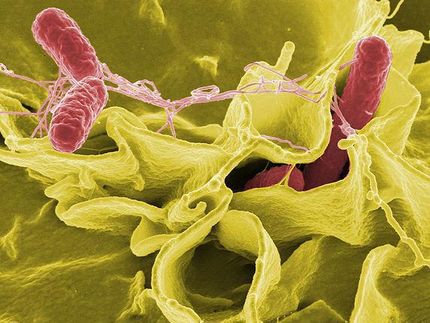Scientists create first mouse model of typhoid fever
Advance will accelerate testing of new vaccines
Columbia University Medical Center (CUMC) researchers have created the first true mouse model of typhoid infection. The development promises to advance the study of typhoid and the creation of new vaccines against the infection, which remains a major health threat in developing countries. The paper was published in Cell.
"Vaccines are the most practical solution for preventing typhoid in the Third World. Unfortunately, existing typhoid vaccines are only modestly effective, leaving millions of people vulnerable to infection. With our new mouse model, the first of its kind, we have a powerful tool for investigating the disease and devising better vaccine strategies," said study co-leader Sankar Ghosh, PhD, the Silverstein and Hutt Family Professor and chair of microbiology & immunology at CUMC.
Typhoid is caused by the bacterium Salmonella typhi, which is spread through contaminated drinking water or food. While typhoid is rare in the United States, it is a common health problem in the developing world, affecting more than 2 million people each year and leading to 200,000 deaths.
Since mice and other laboratory animals are resistant to S. typhi, it has been difficult to develop and test new vaccination approaches. In the current experiment, Dr. Ghosh and his colleagues sought to determine why mice cannot be infected with S. typhi, with the ultimate goal of creating an animal model for studying the disease.
Evidence suggested that toll-like receptors (TLRs), which are expressed on the surface of key immune cells such as macrophages and dendritic cells, might be involved. Such cells are part of the innate immune response, the body's first-line defense against infectious microbes. For various reasons, the researchers zeroed in on a particular TLR: TLR11. One, this receptor is expressed all over the gastrointestinal lining, or epithelium, where S. typhi infection begins, and two, the receptor is found in mice, but not in humans. Also, in an earlier study, the CUMC team found that TLR11 protects mice infected with the Toxoplasma gondii, the parasite that causes toxoplasmosis in humans.
To determine whether TLR11 protects mice against S. typhi, Dr. Ghosh created a strain of mice that lack the receptor. When the TLR11 "knockout" mice were challenged with orally administered S. typhi, they developed typhoid-like symptoms. Next, the researchers demonstrated that the mice could be successfully immunized against S. typhi with a heat-killed vaccine.
The researchers also showed that this protection could be transferred by passive transfer — that is, by taking serum from a vaccinated mouse and giving it to a non-vaccinated mouse. "This is important for two reasons," said study co-leader Matthew S. Hayden, MD, PhD, assistant professor of dermatology and of microbiology & immunology at CUMC. "First, it demonstrated that these mice are capable of a robust response that includes protective antibodies. Second, passive immunization can be used to identify the protective component of the immune response and the parts of the bacteria that vaccination should target."
Other research teams have created small-animal models of typhoid, but all have serious drawbacks. The main drawback is that these models are chimeras, with a mix of mouse and human cells. While these models can be infected with S. typhi, only the human cells are actually infected. Thus, the models do not reflect the animals' true immune response. In addition, these models cannot be infected orally, only by systemic injection. "Normally S. typhi must breach the intestinal barrier and then disseminate within innate immune cells, including intestinal macrophages. Injecting the bacteria systemically bypasses these essential steps in the infection cycle. These are the steps that vaccination should block, however, because bacteria are injected in these other models, efficacy at these steps cannot be tested," said Dr. Hayden.
The CUMC team also discovered that TLR11 protects mice against S. typhi by recognizing and binding to flagellin, a protein found in the bacterium's flagellum, the whip-like tail that it uses to propel itself. The researchers are currently exploring whether TLR11 contributes to the failure of other flagellated bacteria to infect mice. "We are particularly excited that the TLR11 knockout may be an animal model for other enteropathogens" — pathogens that cause intestinal disease — "and potentially, other flagellated epithelial pathogens, including those that infect the lungs and urogenital tract. At present, there are no good mouse models for enterohemorrhagic E. coli, Vibrio cholera, Clostridium difficile, or chronic Pseudomonas aeruginosa," said Dr. Hayden.























































